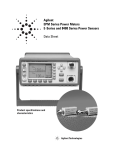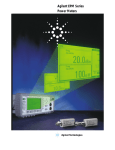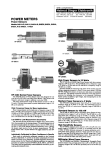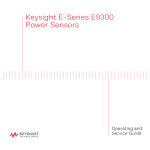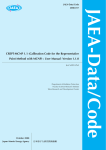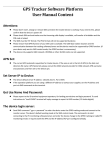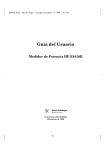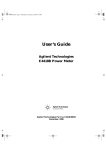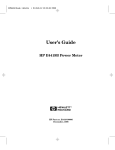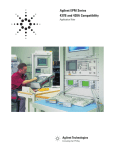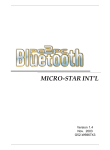Download Agilent Technologies 8481B Product specifications
Transcript
Agilent EPM Series Power Meters E-Series and 8480 Series Power Sensors Data Sheet Product specifications and characteristics EPM series E4418B and E4419B power meters Specifications Accuracy Specifications describe the instrument’s warranted performance and apply after a 30 minute warm-up. These specifications are valid over its operating/environmental range unless otherwise stated and after performing a zero and calibration procedure. Instrumentation Supplemental characteristics Supplemental characteristics (shown in italics) are intended to provide additional information, useful in applying the instrument by giving typical (expected), but not warranted performance parameters. These characteristics are shown in italics or labeled as “typical”, “nominal” or “approximate”. For information on measurement uncertainty calculations, refer to Application Note 64-1C, “Fundamentals of RF and Microwave Power Measurements”, literature number 5965-6380E. Frequency range: 9 kHz to 110 GHz, sensor dependent Absolute: ±0.02 dB (log) or ±0.5% (linear). Please add the corresponding power sensor linearity percentage from tables 7 and 10 (for the E-series sensors) and table 15 (for the 8480 series sensors). Relative: ±0.04 dB (Log) or ±1.0% (linear). Please add the corresponding power sensor linearity percentage from table 16 (for the 8480 series sensors). Zero set (digital settability of zero): sensor dependent (refer to table 1). For E-series sensors, this specification applies to a ZERO performed when the sensor input is not connected to the POWER REF. Power reference Table 1 Model 8481A, 8482A, 8483A, 8485A, 8487A, R8486A, Q8486A, ZERO SET ±50 nW 8481B, 8482B ±50 µW 8481D, 8485D, 8487D ±20 pW 8481H, 8482H ±5 µW R8486D, Q8486D ±30 pW V8486A, W8486A ±200 nW E4412A, E4413A ±50 pW E9300A, E9301A,E9304A 1 ±500 pW E9300B, E9301B 1 ±500 nW E9300H, E9301H 1 ±5 nW 1. Specification applies to the low power path 15% to 75% relative humidity. Power output: 1.00 mW (0.0 dBm). Factory set to ±0.7% traceable to the U.S. National Institute of Standards and Technology. Accuracy: ±1.2% worst case (±0.9% rss) for one year. Power range: –70 dBm to +44 dBm (100 pW to 25 W), sensor dependent. Power sensors: Compatible with all 8480 series and E-series sensors Single sensor dynamic range: 90 dB maximum (E-series sensors), 50 dB maximum ( 8480 series sensors). Display units: Absolute: Watts or dBm. Relative: Percent or dB. Display resolution: Selectable resolution of 1.0, 0.1, 0.01, and 0.001 dB in Log mode, or 1 to 4 digits in linear mode. Default resolution: 0.01 dB in log mode, 3 digits in linear mode. 2 Supplemental characteristics Power reference Frequency: 50 MHz nominal. SWR: 1.05 maximum. Connector: Type N (f), 50 Ω. Measurement speed Three measurement speed modes, over the GPIB, are available as shown, along with the typical maximum measurement speed for each mode. With the E4418B power meter Normal: 20 readings/second x2: 40 readings/second Fast: 200 readings/second With the E4419B, the measurement speed is reduced, for example, with both channels in FAST mode, the typical maximum measurement speed is 100 readings/second. Fast mode is for E-series sensors only. Maximum measurement speed is obtained using binary output and in free run trigger mode. Zero drift of sensors: Sensor dependent, refer to table 2. For E9300 sensors, refer to table 12 for complete data. Table 3 Number of averages Noise multiplier (normal mode) Noise multiplier (x2 mode) Table 2 Model 8481A, 8482A, 8483A, 8485A, 8487A, R8486A, Q8486A Zero drift 1 < ±10 nW Measurement noise2 < 110 nW 8481B, 8482B < ±10 µW < 110 µW 8481D, 8485D, 8487D < ±4 pW < 45 pW 8481H, 8482H < ±1µW < 10 µW R8486D, Q8486D < ±6 pW < 65 pW V8486A, W8486A < ±40 nW < 450 nW E4412A, E4413A < ±15 pW < 70 pW E9300A, E9301A, E9304A3 < ±150 pW < 700 pW E9300B, E9301B3 < ±150 nW < 700 nW E9300H, E9301H3 < ±1.5 nW < 7 nW 1. Within 1 hour after zero set, at a constant temperature, after a 24-hour warm-up of the power meter. 2. The number of averages at 16 for normal mode and 32 for x2 mode, at a constant temperature, measured over a one minute interval and two standard deviations. For E-series sensors, the measurement noise is measured within the low range. Refer to the relevant sensor manual for further information. 3. Specification applies to the low power path, 15% to 75% relative humidity. Measurement noise: Sensor dependent, refer to table 2 and table 3. For E9300 sensors, refer to table 12. Example: 8481D power sensor, normal mode, number of averages = 4. Effects of averaging on noise: Averaging over 1 to 1024 readings is available for reducing noise. Table 2 provides the measurement noise for a particular sensor with the number of averages set at 16 (for normal mode) and 32 (for x2 mode). Use the noise multiplier, for the appropriate mode (normal or x2) and number of averages, to determine the total measurement noise value. Measurement noise calculation: (< 45 pW x 2.75) = < 121 pW. 1 5.5 2 3.89 4 2.75 8 1.94 16 1 32 0.85 64 0.61 128 0.49 256 0.34 512 0.24 1024 0.17 6.5 4.6 3.25 2.3 1.63 1 0.72 0.57 0.41 0.29 0.2 3 EPM series E4418B and E4419B power meters Settling time 1 For 8480 series sensors: Manual filter, 10 dB decreasing power step. Table 4 Number of 1 averages Settling time(s) 0.15 (normal mode) Settling time(s) 0.15 x2 modes): 2 4 8 16 32 64 128 256 512 1024 0.2 0.3 0.5 1.1 1.9 3.4 6.6 13 27 57 0.18 0.22 0.35 0.55 1.1 1.9 3.5 6.9 14.5 33 Auto filter, default resolution, 10 dB decreasing power step (normal and x2 modes): For E-series sensors: In FAST mode (using free run trigger), within the range –50 dBm to +17 dBm, for a 10 dB decreasing power step, the settling time is: E4418B: 10 ms2 E4419B: 20 ms2 Table 5. Manual filter, 10 dB decreasing power step (not across the range switch point) Number of 1 averages Settling time(s) 0.07 (Normal mode) Settling time(s) 0.04 2 4 8 16 32 64 128 256 512 1024 0.12 0.21 0.4 1 1.8 3.3 6.5 13 27 57 0.07 0.12 0.21 0.4 1 1.8 3.4 6.8 14.2 32 1. Settling time: 0 to 99% settled readings over the GPIB 2. When a power step crosses through the sensor’s auto-range switch point, add 25 mS. Refer to the relevant sensor manual for switch point information. 4 For E4412A and E4413A sensors Auto filter, default resolution, 10 dB decreasing power step (not across the range switch point) For E-series E9300A sensors For E-series E9300B and H sensors 5 Power meter functions Accessed by key entry: either hardkeys, or softkey menu, and programmable. Zero: Zeros the meter. (Power reference calibrator is switched off during zeroing.) Cal: Calibrates the meter using internal (power reference calibrator) or external source. Reference cal factor settable from 1% to 150%, in 0.1% increments. Frequency: Entered frequency range is used to interpolate the calibration factors table. Range: 1 kHz to 999.9 GHz, settable in 1 kHz steps. Cal factor: Sets the calibration Factor for the meter. Range: 1% to 150%, in 0.1% increments. Relative: Displays all successive measurements relative to the last displayed value. Offset: Allows power measurements to be offset by –100 dB to +100 dB, settable in 0.001dB increments, to compensate for external loss or gain. Save/recall: Store up to 10 instrument states via the save/recall menu. dBm/W: Selectable units of either Watts or dBm in absolute power; or percent or dB for relative measurements. Filter (averaging): Selectable from 1 to 1024. Auto-averaging provides automatic noise compensation. General characteristics Duty cycle: Duty cycle valuesbetween 0.001% to 99.999%, in 0.001% increments, can be entered to display a peak power representation of measured power. The following equation is used to calculate the displayed peak power value: peak power = measured power/dutycycle. Recorder outputs: Analog 0 to 1 Volt, 1 kΩ output impedance, BNC connector. E4419B recorder outputs are dedicated to channel A and channel B. Sensor cal tables: Selects cal factor versus frequency tables corresponding to specified sensors ( 8480 series only). Limits: High and low limits can be set in the range –150.000 dBm to +230.000 dBm, in 0.001 dBm increments. Preset default values: dBm mode, rel off, power reference off, duty cycle off, offset off, frequency 50 MHz, AUTO average, free run, AUTO range (for E-series sensors). Display: Selectable single and split screen formats are available. A quasi-analog display is available for peaking measurements. The dual channel power meter can simultaneously display any two configurations of A, B, A/B, B/A, A-B, B-A and relative. Rear panel connectors Remote input/output: A TTL logic level is output when the measurement exceeds a predetermined limit. TTL inputs are provided to initiate zero and calibration cycles. RJ-45 series shielded modular jack assembly connector. TTL Output: high =4.8V max; low = 0.2V max TTL Input: high = 3.5V min, 5V max; low = 1V max, -0.3V min. GPIB: Allows communication with an external controller. RS-232/442: Allows communication with an external RS-232 or RS-422 controller. Male/plug 9 position D-subminiature connector Ground: Binding post, accepts 4 mm plug or bare-wire connection. Line power Input voltage range: 85 to 264 VAC, automatic selection. Input frequency range: 50 to 440 Hz. Power requirement: approximately 50 VA (14 Watts) for E4418B and E4419B. 6 Battery Option 001 operational characteristics1 The following information describes characteristic performance based at a temperature of 25°C unless otherwise noted. Typical operating time: up to 3.5 hours with LED backlight on; up to 5.5 hours with LED backlight off (E4418B power meter). Charge time: 2 hours to charge fully from an empty state; 50 minutes charging enables 1 hour of operation with LED backlight on; 35 minutes charging enables 1hr operation with LED backlight off. Power meter is operational whilst charging. Service life: (to 70% of initial capacity at 25°C): 450 charge/ discharge cycles Chemistry: nickel metal hydride Weight: 1kg Environmental characteristics Remote programming General conditions: Complies with the requirements of the EMC Directive 89/336/EEC. This includes Generic Immunity Standard EN 50082-1: 1992 and Radiated Interference Standard EN 55011: 1991/CISPR11:1990, Group 1 Class A. Interface: GBIB interface operates to IEEE 488.2. RS-232 and RS-422 serial interface supplied as standard. Command language: SCPI standard interface commands. 436A and 437B code compatible (E4418B only); 438A code compatible (E4419B only). Operating environment Temperature: 0°C to 55°C. Maximum humidity: 95% at 40°C (non-condensing). Minimum humidity: 15% at 40°C (non-condensing). Maximum altitude: 3000 meters (9840 feet). GPIB compatibility: SH1, AH1, T6, TE0, L4, LE0, SR1, RL1, PP1, DC1, DT1, C0. Non-volatile memory Battery: Lithium polycarbon Monoflouride, approximate lifetime 5 years at 25°C. Storage conditions Storage temperature: –20°C to +70°C. Non-operating maximum humidity: 90% at 65°C (non-condensing). Non-operating maximum altitude: 15240 meters (50,000 feet). General Dimensions: The following dimensions exclude front and rear protrusions. 212.6 mm W x 88.5 mm H x 348.3 mm D (8.5 in x 3.5 in x 13.7 in) Weight Net: E4418B: 4.0 kg (8.8 lb). E4419B: 4.1 kg (9.0 lb). Shipping: E4418B: 7.9 kg (17.4 lb). E4419B: 8.0 kg (17.6 lb). Safety Conforms to the following product specifications: EN61010-1: 1993/IEC 1010-1: 1990 +A1/CSA C22.2 No. 1010-1: 1993 EN60825-1: 1994/IEC 825-1: 1993 Class 1 Low Voltage Directive 72/23/EEC Accessories supplied Power sensor cable 11730A: E4418B has one 1.5 meter (5 ft) sensor cable. E4419B has two 1.5 meter (5 ft) sensor cables. Power cord: One 2.4 meter (7.5 ft) cable. Power plug matches destination requirements. 1. Characteristics describe product performance that is useful in the application of the product, but is not covered by the product warranty. 7 EPM series power meters Additional documentation Accessories E4418B: Single channel EPM series power meter Selections can be made for the localization of the User’s Guide, and an English language Service Manual Option E441xB-908: Rackmount kit (one instrument) Option E441xB-909: Rackmount kit (two instruments) 34131A: Transit case for half-rack 2U high instruments 34141A: Yellow soft carry/ operating case 34161A: Accessory pouch E9287A2: Spare battery pack for the EPM power meter E4419B: Dual channel EPM series power meter Options available Power Option E441xB-001: Mains power and internal rechargeable battery Connectors Option E441xB-002: Parallel rear panel sensor input connector(s) and front panel reference calibrator connector Option E441xB-003: Parallel rear panel sensor input connectors and rear panel reference calibrator connector Calibration documentation Option E441xB-A6J: ANSI Z540 compliant calibration test data with measurement uncertainties Documentation A hard copy and CD version of the English language User’s Guide and Programming Guide is provided with the EPM power meter as standard. A selection can be made to delete the hard copy Option E441xB-OBO: Delete manual set Option E441xB-915: English language Service Manual Option E441xB-916: English language manual set (hard copy Users Guide and Programming Guide) Option E441xB-ABD: German localization (hard copy Users Guide and English Programming Guide) Option E441xB-ABE: Spanish localization (hard copy Users Guide and English Programming Guide) Option E441xB-ABF: French localization (hard copy Users Guide and English Programming Guide) Option E441xB-ABJ: Japanese localization (hard copy Users Guide and English Programming Guide) Complementary equipment 11683A: Range calibrator Verifies the accuracy and linearity of the EPM series power meters. Outputs corresponding to meter readings of 3, 10, 30, 100 and 300 µW and 1, 3, 10, 30 and 100 mW are provided. Calibration uncertainty is ±0.25% on all ranges. Cables Option E441xB-004: Delete power sensor cable Additional cables 11730A: Power sensor and SNS noise source cable, length 1.5 meters (5 ft) 11730B: Power sensor and SNS noise source cable, length 3 meters (10 ft) 11730C: Power sensor and SNS noise source cable, length 6.1 meters (20 ft) 11730D: Power sensor cable, length 15.2 meters (50 ft) 11730E: Power sensor cable, length 30.5 meters (100 ft) 11730F: Power sensor cable, length 61 meters (200 ft) Service options Warranty Included with each EPM series power meter3 is a standard 36 month return to Agilent warranty and service plan. For warranty and service of 5 years, please order 60 months of R-51B. R-51B: Return-to-Agilent warranty and service plan Calibration4 For 3 years, order 36 months of the appropriate calibration plan shown below. For 5 years, specify 60 months. R-50C-001: Standard calibration plan R-50C-002: Standard compliant calibration plan The E-series and 8480 series power sensors have a 12 months return to Agilent warranty and service plan. For more information, contact your local sales and service office. 2. Only for EPM series power meter with Option E441XB-001 installed. 3. For Option E441XB-001, the 36 month warranty does not apply to the E9287A battery pack. 4. Options not available in all countries. 8 E-series power sensor specifications E-series CW power sensor specifications The E-series of power sensors have their calibration factors stored in EEPROM and operate over a wide dynamic range. They are designed for use with the EPM series of power meters and two classes of sensors are available: Table 6 Model E4412A Frequency range 10 MHz – 18 GHz E4413A 50 MHz – 26.5 GHz • CW power sensors (E4412A and E4413A). • Average power sensors (E9300 sensors). Wide dynamic range CW sensors: 100 pW to 100 mW (-70 dBm to +20 dBm) Maximum SWR *10 MHz to 30 MHz: 1.12 30 MHz to 2 Ghz:1.15 2 GHz to 6 Ghz:1.17 6 GHz to 11 Ghz:1.2 11 GHz to 18 Ghz:1.27 50 MHz to 100 MHz: 1.21 100 MHz to 8 Ghz:1.19 8 GHz to 18 Ghz:1.21 18 GHz to 26.5 Ghz:1.26 Maximum power Connector type 200 mW (+23 dBm) Type-N (m) 200 mW (+23 dBm) APC-3.5mm (m) * Applies to sensors with serial prefix US 3848 or greater Power linearity Table 7 Power Temperature (25ºC ±5ºC) 100 pW to 10 mW ±3 % (-70 dBm to +10 dBm) 10 mW to 100 mW ±4.5% (+10 dBm to +20 dBm) Temperature (0º to 55ºC) ±7 % ±10% Figure 1 : Relative mode power measurement linearity with EPM series power meter/E-series CW power sensor at 25°C ± 5°C (typical) 9 The chart in figure 1 shows the typical uncertainty in making a relative power measurement, using the same power meter channel and the same power sensor to obtain the reference and the measured values. Example A illustrates a relative gain (amplifier measurement). Example B illustrates a relative loss (insertion loss measurement). This chart assumes negligible change in frequency and mismatch occur when transitioning from the power level used as the reference to the power level being measured. Example A: P = 10(P)/10 x 1 mW P = 10 6/10 x 1 mW P = 3.98 mW 3% x 3.98 mW = 119.4 µW (where P = power in Watts, and (P) = power in dBm) Example B: P = 10 (P)/10 x1 mW P = 10 -35/10 x 1 mW P = 316 nW 3% x 316 nW = 9.48 nW General Dimensions: E4412A: 130 mm L x 38 mm W x 30 mm H (5.1 in x 1.5 in x 1.2 in) E4413A: 102 mm L x 38 mm W x 30 mm H (4 in x 1.5 in x 1.2 in) Weight: E4412A: 0.18 kg (0.4 lb). E4413A: 0.18 kg (0.4 lb). Calibration factor (CF) and reflection coefficient (Rho) Calibration factor and reflection coefficient data are provided at 1 GHz increments on a data sheet included with the power sensor. This data is unique to each sensor. If you have more than one sensor,match the serial number on the data sheet with the serial number on the power sensor you are using. The CF corrects for the frequency response of the sensor. The EPM power meter automatically reads the CF data stored in the sensor and uses it to make the corrections. For power levels greater than 0 dBm, add 0.5%/dB to the calibration factor uncertainty specification. Reflection coefficient (Rho) relates to the SWR according to the following formula: SWR = 1 + Rho/1 - Rho Maximum uncertainties of the CF data are listed in table 8a, for the E4412A power sensor, and table 8b for the E4413A power sensor. The uncertainty analysis for the calibration of the sensors was done in accordance with the ISO/TAG4 Guide. The uncertainty data reported on the calibration certificate is the expanded uncertainty with a 95% confidence level and a coverage factor of 2. Table 8a. E4412A calibration factor uncertainty at 1 mW (0 dBm) Frequency 10 MHz 30 MHz 50 MHz 100 MHz 1.0 GHz 2.0 GHz 4.0 GHz 6.0 GHz 8.0 GHz 10.0 GHz 11.0 GHz 12.0 GHz 14.0 GHz 16.0 GHz 18.0 GHz Uncertainty (%) 1.8 1.8 Reference 1.8 1.8 2.4 2.4 2.4 2.4 2.4 2.4 2.4 2.4 2.6 2.6 Table 8b. E4413A calibration factor uncertainty at 1 mW (0 dBm) Frequency 50 MHz 100 MHz 1.0 GHz 2.0 GHz 4.0 GHz 6.0 GHz 8.0 GHz 10.0 GHz 11.0 GHz 12.0 GHz 14.0 GHz 16.0 GHz 17.0 GHz 18.0 GHz 20.0 GHz 22.0 GHz 24.0 GHz 26.0 GHz 28.0 GHz Uncertainty (%) Reference 1.8 1.8 2.4 2.4 2.4 2.4 2.6 2.6 2.8 2.8 2.8 2.8 2.8 3 3 3 3 3 10 E-series E9300 average power sensor specifications The E-series E9300 wide dynamic range, average power sensors are designed for use with the EPM family of power meters. These specifications are valid ONLY after proper calibration of the power meter and apply for CW signals unless otherwise stated. Specifications apply over the temperature range 0°C to 55°C unless otherwise stated, and specifications quoted over the temperature range 25°C ±10°C, conform to the standard environmental test conditions as defined in TIA/EIA/ IS-97-A and TIA/EIA/IS-98-A [1]. The E-series E9300 power sensors have two independent measurement paths (high and low power paths): High power path: -10 to +20 dBm (“A” suffix sensors), +20 to +44 dBm (“B” suffix sensors) and 0 to +30 dBm (“H” suffix sensors). Low power path: -60 to -10 dBm (“A” suffix sensors), -30 to +20 dBm (“B” suffix sensors) and -50 to 0 dBm (“H” suffix sensors). Some specifications are detailed for an individual measurement path. Table 9 Wide dynamic range (-60 to +20 dBm) sensors Model Frequency range Maximum SWR (25°C ± 10°C) E9300B 10 MHz – 18.0 GHz 10 MHz to 30 GHz: 1.15 30 MHz to 2 GHz: 1.13 2 GHz to 14 GHz: 1.19 14 GHz to 16 GHz: 1.22 16 GHz to 18 GHz: 1.26 E9301A 10 MHz – 6.0 GHz 10 MHz to 30 GHz: 1.15 30 MHz to 2 GHz: 1.13 2 GHz to 14 GHz: 1.19 E9304A 9 MHz – 6.0 GHz 9 kHz to 2 GHz: 1.13 2 GHz to 6 GHz: 1.19 Maximum SWR (0 – 55°C) 10 MHz to 30 MHz: 1.21 30 MHz to 2 GHz: 1.15 2 GHz to 14 GHz: 1.20 14 GHz to 16 GHz: 1.23 16 GHz to 18 GHz: 1.27 10 MHz to 30 MHz: 1.21 30 MHz to 2 GHz: 1.15 2 GHz to 14 GHz: 1.20 9 kHz to 2 GHz: 1.15 2 GHz to 6 GHz: 1.20 Wide dynamic range (-30 to +44 dBm) sensors Model Frequency range Maximum SWR (25°C ± 10°C) E9300B 10 MHz – 18.0 GHz 10 MHz to 8 GHz: 1.12 8 to 12.4 GHz: 1.17 12.4 to 18 GHz: 1.24 Maximum SWR (0 – 55°C) 10 MHz to 8 GHz: 1.14 8 to 12.4 GHz: 1.18 12.4 to 18 GHz: 1.25 E9301B 10 MHz – 6.0 GHz 10 MHz to 6 GHz: 1.12 10 MHz to 6 GHz: 1.14 Wide dynamic range (-50 to +30 dBm) sensors Model Frequency range Maximum SWR (25°C ± 10°C) E9300H 10 MHz – 18.0 GHz 10 MHz to 8 GHz: 1.15 8 to 12.4 GHz: 1.25 12.4 to 18 GHz: 1.28 E9301H 10 MHz – 6.0 GHz 10 MHz to 6 GHz: 1.15 Maximum SWR (0 – 55°C) 10 MHz to 8 GHz: 1.17 8 to 12.4 GHz: 1.26 12.4 to 18 GHz: 1.29 10 MHz to 6 GHz: 1.17 Maximum power +25 dBm average; +33 dBm peak (< 10 µsec) Connector type Type-N (m) +25 dBm average; +33 dBm peak (< 10 µsec) +25 dBm average; +33 dBm peak (< 10 µsec) Type-N (m) Maximum power Connector type Type-N (m) 0 – 35°C: 30 W avg 35 – 55°C: 25 W avg < 6 GHz: 500 W pk > 6 GHz: 125 W pk 500 W-mS per pulse 0 – 35°C: 30 W avg 35 – 55°C: 25 W avg < 6 GHz: 500 W pk 500 W-mS per pulse Maximum power 3.16 W avg 100 W pk 100 W-µS per pulse 3.16 W avg 100 W pk 100 W-µS per pulse Type-N (m) Type-N (m) Connector type Type-N (m) Type-N (m) 11 Typical SWR, 10 MHz to 18 GHz, (25°C ± 10°C) for E9300A and E9301A sensors Typical SWR, 9kHz to 6 GHz, (25°C ± 10°C) for E9304A sensors 12 Typical SWR, 10 MHz to 18 GHz, (25°C ± 10°C) for E9300B and E9301B sensors Typical SWR, 10 MHz to 18 GHz, (25°C ± 10°C) for E9300H and E9301H sensors 13 E-series E9300 average power sensors Table 10. Power linearity (after zero and cal at ambient environmental conditions) Sensor Power Linearity Linearity (25°C ± 10°C) (0 – 55°C) E9300A, E9301A, E9304A -60 to –10 dBm ±3.0% ±3.5% -10 to 0 dBm ±2.5% ±3.0% 0 to +20 dBm ±2.0% ±2.5% E9300B, E9301B -30 to +20 dBm ±3.5% ±4.0% +20 to +30 dBm ±3.0% ±3.5% +30 to +44 dBm ±2.5% ±3.0% E9300H, E9301H -50 to 0 dBm ±4.0% ±5.0% 0 to +10 dBm ±3.5% ±4.0% +10 to +30 dBm ±3.0% ±3.5% Typical E9300A/01A/04A Power Linearity at 25°C, after zero and calibration, with associated measurement uncertainty Power range Measurement uncertainty -30 to -20 dBm ±0.9% -20 to -10 dBm ±0.8% -10 to 0 dBm ±0.65% 0 to +10 dBm ±0.55% +10 to +20 dBm ±0.45% 14 E-series E9300 average power sensors Typical E9300B/01B power linearity at 25°C, after zero and calibration, with associated measurement uncertainty Power range Measurement uncertainty -6 to 0 dBm ± 0.65% 0 to +10 dBm ± 0.55% +10 to +20 dBm ± 0.45% +20 to +26 dBm ± 0.31% Typical E9300H/01H power linearity at 25°C, after zero and calibration, with associated measurement uncertainty Power range Measurement uncertainty -26 to -20 dBm ± 0.9% -20 to –10 dBm -10 to 0 dBm 0 to +10 dBm +10 to +20 dBm ± 0.8% ± 0.65% ± 0.55% ± 0.45% +20 to +26 dBm ± 0.31% 15 Note: If the temperature changes after calibration and you choose not to re-calibrate the sensor, the following additional power linearity error should be added to the linearity specs in table 10: the typical maximum additional power linearity error due to temperature change after calibration, for small changes in temperature, is ±0.15%/°C (valid after zeroing the sensor). For large changes in temperature, refer to Table 11. Typical maximum additional power linearity error due to temperature change after calibration at 25ºC for any change in temperature (valid after zeroing the sensor) Table 11 Sensor E9300A, E9301A, E9304A E9300B, E9301B E9300H, E9301H Power -60 to –10 dBm -10 to 0 dBm 0 to +20 dBm -30 to +20 dBm +20 to +30 dBm +30 to +44 dBm -50 to 0 dBm 0 to +10 dBm +10 to 30 dBm Additional power linearity error (25°C ± 10°C) ±1.5% ±1.5% ±1.5% ±1.5% ±1.5% ±1.5% ±1.5% ±1.5% ±1.5% Additional power linearity error (0 – 55°C) ±2.0% ±2.5% ±2.0% ±2.0% ±2.5% ±2.0% ±2.0% ±2.5% ±2.0% Figure 2. Relative mode power measurement linearity with an EPM series power meter, at 25°C ±10°C (typical) Figure 2 shows the typical uncertainty in making a relative power measurement, using the same power meter channel and same power sensor to obtain the reference and the measured values, and assumes that negligible change in frequency and mismatch error occur when transitioning from the power level used as the reference to the power level being measured. 16 E-series E9300 average power sensors Switch point data The E9300 power sensors have two paths, a low power path covers: -60 to -10 dBm (“A” suffix sensors), -30 to +20 dBm (“B” suffix sensors), and -50 to 0 dBm (“H” suffix sensors). The high power path covers: 10 to +20 dBm (“A” suffix sensors), +20 to +44 dBm (“B” suffix sensors), and 0 to +30 dBm (“H” suffix sensors). The power meter automatically selects the proper power level path. To avoid unnecessary switching when the power level is near the switch point, switching point hysteresis has been added. Table 12. E9300A, E9301A, and E9304A sensors zero and measurement noise Conditions1 Zero set Zero drift2 Measurement noise3 Low power path 500 pW 150 pW 700 pW (15% to 75% RH) Low power path 500 pW 4,000 pW 700 pW (75% to 95% RH) High power path 500 nW 150 nW 500 nW (15% to 75% RH) High power path 500 nW 3 nW 500 nW (75% to 95% RH) E9300B and E9301B sensors Conditions1 Zero set Low power path 500 nW (15% to 75% RH) Low power path 500 nW (75% to 95% RH) High power path 500 µW (15% to 75% RH) High power path 500 µW (75% to 95% RH) Zero drift2 150 nW Measurement noise3 700 nW 4 µW 700 nW 150 µW 500 µW 3 mW 500 µW Zero drift2 1.5 nW Measurement noise3 7 nW 40 nW 7 nW 1.5 µW 5 µW 30 µW 5 µW E9300 “A” suffix sensors example: hysteresis causes the low power path to remain selected until approximately -9.5 dBm as the power level is increased, above this power the high power path will be selected. The high power path will remain selected until approximately -10.5 dBm is reached as the signal level decreases, below this power the low power path will be selected. E9300H and E9301H sensors Conditions1 Zero set Low power path 5 nW (15% to 75% RH) Low power path 5 nW (75% to 95% RH) High power path 5 µW (15% to 75% RH) High power path 5 µW (75% to 95% RH) Switching point linearity: Typically ≤ ±0.5% (≤ ±0.02 dB) Switching point hysteresis: 0.5 dB typical 1. RH is the abbreviation for relative humidity. 2. Within 1 hour after zero set, at a constant temperature, after a 24-hour warm-up of the power meter with power sensor connected. 3. The number of averages at 16 for normal mode and 32 for x2 mode, at a constant temperature, measured over a one minute interval and two standard deviations. 17 Calibration factor (CF) and reflection coefficient (Rho) Calibration factor and reflection coefficient data are provided at frequency intervals on a data sheet included with the power sensor. This data is unique to each sensor. If you have more than one sensor, match the serial number on the data sheet with the serial number on the power sensor you are using. The CF corrects for the frequency response of the sensor. The EPM series power meter automatically reads the CF data stored in the sensor and uses it to make the corrections. Reflection coefficient (Rho) relates to the SWR according to the following formula: SWR = (1 + Rho)/(1 - Rho) Table 13A. Calibration factor uncertainties (low power path) Frequency Uncertainty (%) (25°C +10°C) 10 MHz to 30 MHz ± 1.8% 30 MHz to 500 MHz ±1.6% (E9304A: 9kHz to 500MHz) 500 MHz to 1.2 GHz ±1.8% 1.2 GHz to 6 GHz ±1.7% 6 GHz to 14 GHz ±1.8% 14 GHz to 18 GHz ± 2.0 % ±2.0% Table 13B Calibration factor uncertainties (high power path) Frequency Uncertainty (%) (25°C +10°C) 10 MHz to 30 MHz ±2.1% 30 MHz to 500 MHz ±1.8% (E9304A: 9kHz to 500MHz) 500 MHz to 1.2 GHz ±2.3% 1.2 GHz to 6 GHz ±1.8% 6 GHz to 14 GHz ±1.9% 14 GHz to 18 GHz ±2.2% Uncertainty (%) (0° to 55°C) ±2.2% ±2.0% ±2.5% ±2.0% ±2.2% Uncertainty (%) (0° to 55°C) ±4.0% ±3.0% ±4.0% ±2.1% ±2.3% ±3.3% Maximum uncertainties of the CF data are listed in tables 13A and 13B. As the E-series E9300 power sensors have two independent measurement paths (high and low power paths), there are two calibration factor uncertainty tables. The uncertainty analysis for the calibration of the sensors was done in accordance with the ISO Guide. The uncertainty data reported on the calibration certificate is the expanded uncertainty with a 95% confidence level and a coverage factor of 2. General Dimensions: Length 130 mm, width 38 mm, height 30 mm Weight: 0.18 kg (0.4 lbs) References: [1] TIA is the Telecommunications Industry Association; EIA is the Electronic Industries Association. TIA/EIA/IS-97-A is the recommended minimum performance standards for base stations supporting dualmode wideband spread spectrum cellular mobile stations. TIA/EIA/ IS-98-A is the recommended minimum performance standards for dual-mode wideband spread spectrum cellular mobile stations. 18 8480 series power sensors (with EPM series power meters) The 8480 series power sensors are designed for use with the 435B, 436A, 437B, 438A, 70100A, E1416A and now the E4418B and E4419B power meters. These thermocouple and diode power sensors provide extraordinary accuracy, stability, and SWR over a wide range of frequencies (100 kHz to 110 GHz) and power levels -70 dBm to +44 dBm). Table 14. Root sum of squares (rss) uncertainty on the calibration factor data printed on the power sensor Freq (MHz) 0.1 0.3 1 3 10 30 50 100 300 1000 2000 4000 8482A 8482B 8482H 8483A 1.3 1.2 1.2 1.2 1.3 1.4 0 (ref) 1.6 1.6 1.4 1.4 1.5 2.8 2.8 2.8 2.8 2.8 2.8 2.7 3.3 3.3 3.3 3.3 3.1 1.6 1.6 1.6 1.6 1.6 1.7 0 (ref) 1.9 1.9 1.7 1.7 1.8 1.5 1.4 1.4 1.4 1.6 1.6 0 (ref) 2 2 2 2.1 - Freq (GHz) 1 2 4 6 8 10 12 14 16 18 22 26.5 8481A 1.6 1.4 1.5 1.5 1.7 1.9 2.1 2.6 2.9 3.2 - 8481B 3 3.1 3.1 3.1 3.2 3.3 4.1 4.1 4.2 4.3 - 8481H 1.9 1.7 1.8 1.8 2 2.2 2.4 2.8 3 3.1 - 8481D 1.9 1.8 1.8 1.8 2 2.2 2.8 3.2 3.4 3.7 - 8485A 1.6 1.6 1.7 1.8 1.9 2 2 2.2 2.3 2 2.1 2.1 8385D 1.8 1.8 1.8 2.1 2.2 2.1 2.2 2.2 2.5 2.6 2 2.3 Freq (GHz) 26.5 28 30 33 34.5 37 40 42 44 46 48 50 R8486A 2.2 2.4 2.5 2.1 2.1 2.2 2.2 - Q8486A 2.8 2.8 2.8 2.9 3.9 3.9 3.9 4.9 5.3 R8486D 3 3.2 3 3 3 3 3 - Q8486D 4.2 4.2 4.2 4.2 4.9 5.1 5.5 5.8 6.2 8487A 2.1 2.3 2.1 2.3 2.1 2.3 2.6 3.2 3.6 4.1 4.5 5 8487D 2.8 3 3 3 3 3 3 2.9 2.9 3.1 4.5 4.5 8487A 1.6 1.6 1.6 1.7 1.8 1.8 1.9 2.1 2.2 2.3 1.8 2.1 8487D 2 2 2 2.3 2.3 2.3 2.3 2.8 2.8 2.8 2.8 2.8 19 8480 series sensors (with EPM series power meters) Table 15 25 Watt sensors, 1 mW to 25 W (0 dBm to +44 dBm) Model Frequency range Maximum SWR Power linearity1 8481B 10 MHz to 18 GHz 10 MHz to 2 GHz: 1.10 2 GHz to 12.4 GHz: 1.18 +35 dBm to + 44 dBm: (±4%) 12.4 GHz to 18 GHz: 1.28 8482B 100 kHz to 4.2 GHz 100 kHz to 2 GHz: 1.10 2 GHz to 4.2 GHz: 1.18 +35 dBm to + 44 dBm: (±4%) 10 MHz to 18 GHz 8482H 100 kHz to 4.2 GHz 10 MHz to 8 GHz: 1.20 8 GHz to12.4 GHz: 1.25 12.4 GHz to 18 GHz: 1.30 100 kHz to 4.2 GHz: 1.20 Connector type Weight Type - N(m) Net: 0.8 kg (1.75 lb) Shipping: 1.5 kg (3.25 lb) Type - N(m) Net: 0.8 kg (1.75 lb) Shipping: 1.5 kg (3.25 lb) 0.01 to 5.8 GHz: 500W pk 5.8 to 18 GHz: 125 W pk 500 W.µs per pulse 0°C to 350°C: 30W avg 2 35°C to 550°C: 25W avg 0.01 to 5.8 GHz: 500W pk 5.8 to 18 GHz: 125 W pk 500 W - µs per pulse 3 Watt sensors, 100 µW to 3 W (–10 dBm to +35 dBm) Model Frequency range Maximum SWR Power linearity (1) 8481H Maximum power 0°C to 350°C: 30W avg 2 35°C to 550°C: 25W avg Maximum power Connector type Weight +25 dBm to + 35 dBm: (±5%) 3.5 W avg, 100 W pk 100 W.µs per pulse Type - N (m) Net: 0.2 kg (0.38 lb) Shipping: 0.5 kg (1.0 lb) +25 dBm to + 35 dBm: (±5%) 3.5 W avg, 100 W pk 100 W.µs per pulse Type - N (m) Net: 0.2 kg (0.38 lb) Shipping: 0.5 kg (1.0 lb) 100 mW sensors, 1 µW to 100 mW (–30 dBm to +20 dBm) Model Frequency range Maximum SWR Power linearity (1) Maximum power Connector type Weight 50 MHz to 26.5 GHz 50 MHz to 100 MHz: 1.15 100 MHz to 2 GHz: 1.10 2 GHz to 12.4 GHz: 1.15 12.4 GHz to 18 GHz: 1.20 18 GHz to 26.5 GHz: 1.25 Option 50 MHz to 33 GHz 26.5 GHz to 33 GHz: 1.40 8485A-033 8481A 10 MHz to 18 GHz 10 MHz to 30 MHz: 1.40 30 MHz to 50 MHz: 1.18 50 MHz to 2 GHz: 1.10 2 GHz to 12.4 GHz: 1.18 12.4 GHz to 18 GHz: 1.28 8482A 100 kHz to 4.2 GHz 100 kHz to 300 kHz: 1.60 300 kHz to 1 MHz: 1.20 1 MHz to 2 GHz: 1.10 2 GHz to 4.2 GHz: 1.30 8483A 100 kHz to 2 GHz 100 kHz to 600 kHz: 1.80 (75 ohm) 600 kHz to 2 GHz: 1.18 R8486A 26.5 GHz to 40 GHz 26.5 GHz to 40 GHz: 1.40 +10 dBm to + 20 dBm: (±3%) 300 mW avg, 15 W pk 30 W.µs per pulse APC - 3.5mm(m) Net: 0.2 kg (.38 lb) Shipping: 0.5 kg (1.0 lb) +10 dBm to + 20 dBm: (±3%) 300 mW avg, 15 W pk 30 W.µs per pulse 300 mW avg, 15 W pk 30 W.µs per pulse APC - 3.5mm(m) Net: 0.2 kg (.38 lb) Shipping: 0.5 kg (1.0 lb) Net: 0.2 kg (0.38 lb) Shipping: 0.5 kg (1.0 lb) Q8486A 33 GHz to 50 GHz 33 GHz to 50 GHz: 1.50 +10 dBm to + 20 dBm: (±3%) V8486A 50 GHz to 75 GHz 50 GHz to 75 GHz: 1.06 +10 dBm to + 20 dBm: (±2%) -30 dBm to + 10 dBm: (±1%) W8486A 75 GHz to 110 GHz 75 GHz to 110 GHz: 1.08 (±2%) 8487A 50 MHz to 100 MHz: 1.15 100 MHz to 2 GHz: 1.10 2 GHz to 12.4 GHz: 1.15 12.4 GHz to 18 GHz: 1.20 18 GHz to 26.5 GHz: 1.25 26.5 GHz to 40 GHz: 1.30 40 GHz to 50 GHz: 1.50 +10 dBm to + 20 dBm: (±3%) 8485A 1. 2. 50 MHz to 50 GHz +10 dBm to + 20 dBm: (±3%) Type - N (m) +10 dBm to + 20 dBm: (±3%) 30 W.µs per pulse 300 mW avg, 15 W pk Type - N (m) Net: 0.2 kg (0.38 lb) Shipping: 0.5 kg (1.0 lb) +10 dBm to + 20 dBm: (±3%) 300 mW avg, 10 W pk +10 dBm to + 20 dBm: (±3%) 300 mW avg, 15 W pk 30 W.µs per pulse 300 mW avg, 15 W pk 30 W.µs per pulse 200 mW avg, 40 W pk (10.µs per pulse, 0.5% duty cycle) 200 mW avg, 40 W pk (10.µs per pulse, 0.5% duty cycle) 300 mW avg, 15 W pk 30 W.µs per pulse Type - N (m) (75 ohm) Waveguide flange UG-385/U Waveguide flange UG-385/U Waveguide flange UG-385/U Net: 0.2 kg (0.38 lb) Shipping: 0.5 kg (1.0 lb) Net: 0.26 kg (0.53 lb) Shipping: .66 kg (1.3 lb) Net: 0.26 kg (0.53 lb) Shipping: .66 kg (1.3 lb) Net: 0.4 kg (0.9 lb) Shipping: 1 kg (2.1 lb) Waveguide flange UG-385/U Net: 0.4 kg (0.9 lb) Shipping: 1 kg (2.1 lb) 2.4 mm (m) Net: 0.14 kg (.28 lb) Shipping: 0.5 kg (1.0 lb) Negligible deviation except for those power ranges noted. For pulses greater than 30 W, the maximum average power (Pa) is limited by the energy per pulse (E) in W.µs according to Pa = 30-0.02 E. 20 8480 series sensors (with EPM series power meters) High sensitivity sensors, 100 pW to 10 µW (–70 dBm to –20 dBm) Model Frequency range Maximum SWR Power linearity1 Maximum power Connector type Weight 8481D3 10 MHz to 18 GHz 10 MHz to 30 MHz: 1.40 - 30 dBm to - 20 dBm: (±1%) 100 mW avg, 100 m W pk Type - N (m) Net: 0.16 kg (0.37 lb) 30 MHz to 3 GHz: 1.15 Shipping: 0.9 kg (2.0 lb) 4 GHz to 10 GHz: 1.20 10 GHz to 15 GHz: 1.30 15 GHz to 18 GHz: 1.50 8485D3 50 MHz to 26.5 GHz 0.05 GHz to 0.1 GHz: 1.19 -30 dBm to -20 dBm: (±2%) 100 mW avg, 100 m W pk APC - 3.5mm (m) 0.1 GHz to 4 GHz: 1.15 Net: 0.2 kg (.38 lb) Shipping: 0.5 kg (1.0 lb) 4 GHz to 12 GHz: 1.19 12 GHz to 18 GHz: 1.25 18 GHz to 26.5 GHz: 1.29 Option 50 MHz to 33 GHz 26.5 GHz to 33 GHz: 1.35 -30 dBm to -20 dBm: (±2%) 100 mW avg, 100 m W pk APC - 3.5mm (m) Net: 0.2 kg (.38 lb) 8485D-033 8487D3 50 kHz to 50 GHz 0.05 GHz to 0.1 GHz: 1.19 -30 dBm to -20 dBm: (±2%) 100 mW avg, 100 m W pk 2.4 mm (m) Net: 0.2 kg (0.38 lb) Shipping: 0.5 kg (1.0 lb) 0.1 GHz to 4 GHz: 1.15 30 W.µs per pulse Shipping: 0.5 kg (1.0 lb) 2 GHz to 12.4 GHz: 1.20 12.4 GHz to 18 GHz: 1.29 18 GHz to 34 GHz: 1.37 34 GHz to 40 GHz: 1.61 40 GHz to 50 GHz: 1.89 R8486D3 Q8486D3 1. 2. 3. 26.5 GHz to 40 GHz 33 GHz to 50 GHz 26.5 GHz to 40 GHz: 1.40 33 GHz to 50 GHz: 1.40 -30 dBm to -25 dBm: (±3%) 100 mW avg, or pk Waveguide flange -25 dBm to -20 dBm: (±5%) 40 V dc max UG-599/U Net: 0.26 kg (0.53 lb) Shipping: .66 kg (1.3 lb) -30 dBm to 25 dBm: (±3%) 100 mW avg, or pk Waveguide flange Net: 0.26 kg (0.53 lb) -25 dBm to -20 dBm: (±5%) 40 V dc max UG-383/U Shipping: 0.66 kg (1.3 lb) Negligible deviation except for those power ranges noted. For pulses greater than 30 W, the maximum average power (Pa) is limited by the energy per pulse (E) in W.µs according to Pa = 30-0.02 E. Includes 11708A 30 dB attenuator for calibrating against 0 dBm, 50 MHz power reference. The 11708A is factory set to 30 dB ±0.05 dB at 50 MHz, traceable to NIST. SWR < 1.05 at 50 MHz. 21 Agilent Technologies’ Test and Measurement Support, Services, and Assistance Agilent Technologies aims to maximize the value you receive, while minimizing your risk and problems. We strive to ensure that you get the test and measurement capabilities you paid for and obtain the support you need. Our extensive support resources and services can help you choose the right Agilent products for your applications and apply them successfully. Every instrument and system we sell has a global warranty. Support is available for at least five years beyond the production life of the product. Two concepts underlie Agilent’s overall support policy: “Our promise” and “Your Advantage.” Our Promise Our Promise means your Agilent test and measurement equipment will meet its advertised performance and functionality. When you are choosing new equipment, we will help you with product information, including realistic performance specifications and practical recommendations from experienced test engineers. When you use Agilent equipment, we can verify that it works properly, help with product operation, and provide basic measurement assistance for the use of specified capabilities, at no extra cost upon request. Many self-help tools are available. Your Advantage Your Advantage means that Agilent offers a wide range of additional expert test and measurement services, which you can purchase according to your unique technical and business needs. Solve problems efficiently and gain a competitive edge by contracting with us for calibration, extra-cost upgrades, out-of-warranty repairs, and on-site education and training, as well as design, system integration, project management, and other professional engineering services. Experienced Agilent engineers and technicians worldwide can help you maximize your productivity, optimize the return on investment of your Agilent instruments and systems, and obtain dependable measurement accuracy for the life of those products. Get the latest information on the products and applications you select. By internet, phone, or fax, get assistance with all your test & measurement needs Online assistance: www.agilent.com/find/assist Phone or Fax United States: (tel) 800 452 4844 Canada: (tel) 877 894 4414 (fax) 905 282 6495 China: (tel) 800 810 0189 (fax) 800 820 2816 Europe: (tel) (31 20) 547 2323 (fax) (31 20) 547 2390 Japan: (tel) (81) 426 56 7832 (fax) (81) 426 56 7840 Agilent Email Updates www.agilent.com/find/emailupdates Get the latest information on the products and applications you select. Korea: (tel) (82 2) 2004 5004 (fax) (82 2) 2004 5115 Latin America: (tel) (305) 269 7500 (fax) (305) 269 7599 Taiwan: (tel) 0800 047 866 (fax) 0800 286 331 Other Asia Pacific Countries: (tel) (65) 6375 8100 (fax) (65) 6836 0252 Email: [email protected] Product specifications and descriptions in this document subject to change without notice. © Agilent Technologies, Inc. 2002 Printed in USA, June 13, 2002 5965-6382E 22 Agilent EPM Series Power Meters The standard just got better! What’s new? • Fast measurement speeds (up to 200 readings per second) • Wide dynamic range sensors (-70 dBm to +44 dBm), sensor dependent • Calibration factors stored in EEPROM • Rechargeable battery option Agilent Technologies power meters have long been recognized as the industry standard for RF and microwave power measurements. Now, with our latest generation of power meters and sensors, Agilent provides totally updated and exciting choices. E4418B single-channel power meter The EPM series of power meters is comprised of: • E4418B single-channel power meter • E4419B dual-channel power meter and the E-series of power sensors (see table at left). The E-series power sensors are characterized by having their calibration factors, linearity, and temperature compensation data all stored in EEPROM and have a wide dynamic range. This series of power sensors only operate with the EPM power meters. For more information on the E9300 power sensors, refer to the Product Overview, 5968-4960E. E4419B dual-channel power meter Compatibility– Agilent protects your investment E4412A power sensor and E4413A power sensor. E-Series Power Sensors, CW Family Model E4412A E4413A Frequency Range 10 MHz to 18 GHz 50 MHz to 26.5 GHz Power Range -70 to +20 dBm -70 to +20 dBm E-Series Power Sensors, Average Power Family Model E9300A E9301A E9304A E9300B E9301B E9300H E9301H 2 Frequency Range 10 MHz to 18 GHz 10 MHz to 6 GHz 9 kHz to 6 GHz 10 MHz to 18 GHz 10 MHz to 6 GHz 10 MHz to 18 GHz 10 MHz to 6 GHz Power Range -60 to +20 dBm -60 to +20 dBm -60 to +20 dBm -30 to +44 dBm -30 to +44 dBm -50 to +30 dBm -50 to +30 dBm Operates with 8480 series power sensors! Because Agilent understands the need to protect your investment in power sensors, the EPM series power meters have been designed to be fully compatible with the 8480 series power sensors. Works with 436A, 437B, and 438A code1! The development of automatic test procedures, software generation, and verification are expensive tasks. To help protect your investment, we’ve designed the new E4418B power meter to be code-compatible with the 436A and 437B, and the E4419B to be code-compatible with the 438A. It’s therefore a quick and simple task to make many power measurements in an automatic test equipment (ATE) system using existing 436A, 437B and 438A code. This is achieved by softkey selection. 1 The Agilent EPM series provides a high degree of compatibility with 436A/437B/438A code. However, backwards compatibility can never be 100% guaranteed. For an application note on EPM series compatibility, visit our Web site at www.tm.agilent.com or ask your sales representative for literature number 5968-4519E. Designed for manufacturing Fast speed means increased productivity Fast measurement speed is essential in the high volume manufacturing of RF and microwave components and systems. Faster test time improves your productivity—letting you test more devices in less time. E-series sensors along with the E4418B power meter provide a FAST measurement mode that lets you make up to 200 readings per second. There’s also a x2 mode with the EPM series power meters and 8480 series sensor combination—doubling your speed compared to the 437B and 8480 series combination. No more slow range switch delays! A common problem with most power meters is the time delay that occurs when the power being measured crosses a range switch point. Range switching delays are either significantly reduced or eliminated when an EPM series power meter is used with an E-series sensor. This power measurement combination has only one fast range switch point across the entire dynamic range of the sensor. ... yet more useful functions ... SCPI compatible - EPM power meters conform to the Standard Commands for Programmable Instruments (SCPI). RS232/422 interface - both RS232 and RS422 serial interfaces can be used to remotely control the EPM series power meters. Limit testing - EPM series power meters can be configured to verify the power being measured against an upper and / or lower limit. Limit failures are indicated on the power meter’s display and over the GPIB. Zero/cal lockout - can be enabled to prevent the EPM series power meter from making measurements until the connected sensor is zeroed and calibrated. Channel offset - EPM series power meters can be configured to compensate for signal loss or gain in your test setup. Height and width compatibility allows easy replacement in rackmount systems The EPM series power meters are the same height and width as the 437B and 438A— making them easy to substitute in rackmount systems. The following options are available2: E441xB-002 - rear panel sensor input(s) with the Power Reference Calibrator on the front panel. E441xB-003 - rear panel sensor input(s) with the Power Reference Calibrator on the rear panel. E441xB-908 - rackmount kit for one instrument. E441xB-909 - rackmount kit for two instruments. 2 Rigorous environmental testing and high-reliability qualifies the EPM power meters for your most demanding measurement applications. These options are available for an extra cost. 3 Large LCD display High resolution display with back lighting provides a wide viewing angle for all the displayed data. Preset/local Returns the power meter to local control. If already in local, returns the power meter to the default condition. Arrowkeys Allow positioning of the cursor for editing purposes and for character selection. Softkeys Provide user menu selection. Power ref 1.00 mW, 50 MHz source used for power sensor calibration (traceable to NIST). Display keys Select the active display window. Selectable single and split screen formats. System/inputs Accesses the menus associated with the general power meter setup (for example, the GPIB address, sensor cal tables). Also accesses input offsets, averages, and other input data. Save/recall: Save and recall up to 10 instrument states. Meas setup Accesses the menus associated with the Measurement Setup (for example, selection of the digital or analog meter). Also accesses ratio measurements on the dualchannel power meter. 4 Frequency/cal fac Frequency: Direct entry of the test signal frequency. Cal factor: For sensor frequency response correction (settable from 1% to 200% with 0.1% resolution). dBm/W Selectable units of either Watts or dBm in absolute power, or percent, or dB for relative measurements. Rel: Relative mode uses displayed value as reference (when active). Offset: Display offset values from -99.99 dB to +99.99 dB can be set up. Zero/cal Zero: Fully automatic digital zero corrects for residual offsets. Cal: Fully automatic sensor calibration. Sensor connector(s) Sensor input operates with Agilent 8480 series and E-series power sensors. This is the E4418B single-channel power meter. The E4419B has A and B channel inputs. Easy to learn ... easy to use Increase your productivity with an easy-to-learn, easy-to-use power meter. The EPM series has been designed with the user in mind. Hardkeys such as ZERO/CAL allow access to the most frequently used power meter functions. Softkeys provide measurement control through user selection. The high resolution LCD display (with backlighting), large characters, and split screens provide easy viewing of information. Rear panel features • DC recorder output, 0 to 1 Volt. The Agilent E4419B has two DC recorder outputs. •E441xB-002 provides rear panel sensor inputs with the power reference oscillator on the front panel. •E441xB-003 provides parallel rear panel sensor inputs and moves the power reference oscillator to the rear panel. •GPIB connector for remote control of all functions. •RS232/422 connector for remote control. •Line power - universal input voltage range with NO range selection switches. •Ground connector - for those applications where you need a hard-wired connection between the power meter’s ground and a common ground. •Power meter conforms to CE and CSA standards. •Remote input / output - TTL logic level is output when a measurement exceeds a predetermined limit. TTL inputs are provided to initiate zero and calibration cycles. 5 Designed for installation and maintenance Wide dynamic range allows high and low power measurements with a single sensor One E-series CW sensor covers the range -70 to +20 dBm, while the E9300 sensors operate from -60 to +44 dBm (25W), depending on the sensor. This wide dynamic range capability saves you time and money as you can measure both high (transmitter monitor points) and low (receiver) power levels using a single sensor. Often using just one sensor reduces the requirement for multiple sensor reconnections and the associated mandatory zero and calibration procedures. Stored sensor calibration factors for best accuracy and ease of use Now you no longer have to key in the sensor calibration factors to achieve optimum measurement accuracy. The E-series sensor calibration factors (computed at our factory or Agilent Technologies Service Center) are programmed into measurement points across the frequency range of the sensor and stored in EEPROM. Rugged and portable makes it ideal for field use The optional rechargeable battery (option 001), which provides up to 5.5 hours of continuous operation, means you can use the EPM series power meters in a mains-free environment. The battery charges in less than three hours, during which time the meter can be used, and the charge level indicators keep you informed of the battery status at all times. The soft carry / operating case (34141A) makes it easy to use the EPM series power meter in installation and maintenance environments. Front and rear-panel bumpers protect the power meter from everyday knocks. A bail handle makes it easy to carry. The EPM series power meters are lightweight—weighing approximately 4kg (9 lb). At power-on, or when the sensor is connected, the calibration factors are automatically downloaded into the EPM series power meter. This eliminates measurement errors caused by wrongly keyed-in calibration factor data. Not all installation and maintenance environments are temperature controlled. Therefore, it is important to have confidence in your power measurements over a wide temperature range. E-series sensors provide temperature correction information. This ensures that the best power measurement accuracy is maintained over the full 0 to 55˚C temperature range. 6 The accessories available for the EPM series power meters are ideal for installation and maintenance situations. The battery option and operating case bring Agilent’s power accuracy and ease-of-use to field applications. Versatile display is suitable for your measurement needs In the installation and maintenance environment, it is important to be able to see the power meter’s display from a distance and in a variety of lighting conditions. The EPM series power meter has been designed to meet this need. Contrast adjustment lets you set the brightness of the display. With the internal battery Option E441xB-0013 installed, the LED backlight can be switched off to conserve battery charge levels. The backlight “timed” mode switches the backlight off after 10 minutes of inactivity, again, to maximize battery operation. The display’s wide viewing angle lets you read the large characters and digits, or the analog peaking meter, from a distance. You can display both the digital and analog types of readout using the meter’s split screen facility. The analog peaking meter helps you make accurate adjustments. User-defined upper and lower scale limits, either in dBm or Watts, allow you to control the sensitivity of the displayed adjustment. In subdued lighting conditions, you can easily read the high resolution display. The E-series and 8480 series sensors can operate with long sensor cables. Cable lengths up to 61 meters (200 feet) can be used in conjunction with the 8480 series sensors. So, when you are inside a radio station or up a radio mast, those awkward transmitter and receiver adjustments are made easy using long sensor cables. 3 Available for an extra cost. In this setup, the top half of the split display shows the analog peaking meter while the bottom display shows the same measurement with a larger character size. 7 Designed for R&D Optimum measurement accuracy and repeatability means confidence in your power measurements The EPM series power meters maintain the high accuracy standard set by the Agilent 437B and 438A— being designed to have excellent linearity. Instrumentation absolute accuracy, due to the meter electronics, is specified to be +0.02 dB in logarithmic mode and +0.5% in linear mode—making this source of error a negligible part of the overall measurement uncertainty. In RF and microwave power measurements, the largest errors are caused by: • Sensor and source mismatch, and • Sensor frequency response, non-linearity, and temperature characteristics. With the E4419B, ratio and difference measurements can be made. Here the upper half of the display shows the gain of a GSM amplifier while the lower half of the display shows the B Channel absolute power measurement in dBm. To minimize the mismatch error, the E-series sensors have a low VSWR specification. To provide comprehensive error correction, the calibration factors, linearity and temperature error correction information are stored in EEPROM. Error correction is performed within the power meter. Frequency data is entered by the user. Taking account of the signal level, the frequency being measured, and the temperature, appropriate correction values are applied to the measurement. This error correction process ensures optimum measurement accuracy and repeatability over the full 0 to 55˚C temperature range. User friendly interface for quick setup times The power meter has an intuitive user interface. Hardkeys for the most frequently used functions and softkey menus simplify configuring the power meter for your particular measurement needs. To reduce repeated setup sequences, the SAVE/RECALL menu allows you to save up to 10 instrument configurations. 8 Designed for R&D More choice means the correct sensor for your application The EPM series power meter’s compatibility with both the 8480 series and E-series sensors provides R&D engineers with more choice: • The EPM series power meter and 8480 series sensor combination form a high precision, average power measurement system operating in the frequency range 100 kHz to 110 GHz (depending on the selected sensor) over a 50 dB maximum dynamic range. • The EPM series power meter and E-series sensor combination is ideal for measuring signals in the frequency range 9 kHz to 26.5 GHz, over a wide dynamic range, from -70 dBm to +44 dBm, (depending on the selected sensor). EPM power meter options4 Power E441xB-001 Mains power and internal rechargeable battery Connectors E441xB-002 Parallel rear panel sensor input connector(s) and front panel reference calibrator connector E441xB-003 Parallel rear panel sensor input connector(s) and rear panel reference calibrator connector Calibration documentation E441xB-A6J ANSI Z540 compliant calibration test data including measurement uncertainties Documentation A hard copy and CD version of the English language User’s Guide and Programming Guide is provided with the EPM power meter as standard. A selection can be made to delete the hard copy. E441xB-0B0 Delete manual set Cables E441xB-004 Delete power sensor cable Additional cables 11730A Power sensor and SNS noise source cable, length 5 ft (1.5 m) 11730B Power sensor and SNS noise source cable, length 10 ft (3 m) 11730C Power sensor and SNS noise source cable, length 20 ft (6.1 m) 11730D Power sensor cable, length 50 ft (15.2 m) 11730E Power sensor cable, length 100 ft (30.5 m) 11730F Power sensor cable, length 200 ft (61.0 m) Accessories E441xB-908 Rackmount kit (one instrument) E441xB-909 Rackmount kit (two instruments) 34131A Transit case for half-rack 2U high instruments 34141A Yellow soft carry / operating case 34161A Accessory pouch E9287A5 Spare battery pack for the EPM power meter Additional documentation Selections can be made for the localization of the User’s Guide and an English language Service Manual. E441xB-915 English language Service Manual E441xB-916 English language manual set (hard copy User’s Guide and Programming Guide) E441xB-ABD German localization (hard copy User’s Guide and English Programming Guide) E441xB-ABE Spanish localization (hard copy User’s Guide and English Programming Guide) E441xB-ABF French localization (hard copy User’s Guide and English Programming Guide) E441xB-ABJ Japanese localization (hard copy User’s Guide and English Programming Guide) 4 5 9 With the exception of “delete” options, these are available for an extra charge. Only for EPM series power meter with Option E441xB-001 installed. 10 11 Service and support Traceability to NIST Agilent’s power measurements are traceable to the US National Institute of Standards and Technology (NIST). Quality and reliability Agilent’s power meters and sensors are manufactured in ISO9002 registered facilities in accordance with Agilent’s commitment to quality. The reliability of these instruments is proven through extensive environmental testing. Warranty and extended warranty Included with each EPM series power meter 6 is a standard three-year return-to-Agilent service warranty. The E-series sensors have a one-year return-to-Agilent service warranty. Support options to extend warranty or cover periodic calibrations are available. For more information, contact your local Agilent sales office. Literature reference Agilent Technologies’ Test and Measurement Support, Services, and Assistance Agilent Technologies aims to maximize the value you receive, while minimizing your risk and problems. We strive to ensure that you get the test and measurement capabilities you paid for and obtain the support you need. Our extensive support resources and services can help you choose the right Agilent products for your applications and apply them successfully. Every instrument and system we sell has a global warranty. Support is available for at least five years beyond the production life of the product. Two concepts underlie Agilent’s overall support policy: “Our promise” and “Your Advantage.” Our Promise Our Promise means your Agilent test and measurement equipment will meet its advertised performance and functionality. When you are choosing new equipment, we will help you with product information, including realistic performance specifications and practical recommendations from experienced test engineers. When you use Agilent equipment, we can verify that it works properly, help with product operation, and provide basic measurement assistance for the use of specified capabilities, at no extra cost upon request. Many self-help tools are available. Your Advantage Your Advantage means that Agilent offers a wide range of additional expert test and measurement services, which you can purchase according to your unique technical and business needs. Solve problems efficiently and gain a competitive edge by contracting with us for calibration, extra-cost upgrades, out-of-warranty repairs, and onsite education and training, as well as design, system integration, project management, and other professional engineering services. Experienced Agilent engineers and technicians worldwide can help you maximize your productivity, optimize the return on investment of your Agilent instruments and systems, and obtain dependable measurement accuracy for the life of those products. Get the latest information on the products and applications you select. By internet, phone, or fax, get assistance with all your test & measurement needs. Online assistance: www.agilent.com/find/assist Phone or Fax EPM Series Power Meters and E-series Power Sensors Data Sheet 5965-6382E EPM Series Power Meters and E-series Power Sensors Configuration Guide 5965-6381E Fundamentals of RF and Microwave Power Measurements Application Note 64-1C 5965-6630E 4 Steps for Better Power Measurements Application Note 64-4C 5965-8167E E-Series E9300A Power Sensors Product Overview 5968-4960E 6 For Option E441xB-001, the 3 year warranty does not apply to the E9287A battery pack. United States: (tel) 800 452 4844 Canada: (tel) 877 894 4414 (fax) 905 282 6495 China: (tel) 800 810 0189 (fax) 800 820 2816 Europe: (tel) (31 20) 547 2323 (fax) (31 20) 547 2390 Japan: (tel) (81) 426 56 7832 (fax) (81) 426 56 7840 Korea: (tel) (82 2) 2004 5004 (fax) (82 2) 2004 5115 Latin America: (tel) (305) 269 7500 (fax) (305) 269 7599 Taiwan: (tel) 0800 047 866 (fax) 0800 286 331 Other Asia Pacific Countries: (tel) (65) 6375 8100 (fax) (65) 6836 0252 Email: [email protected] Agilent Email Updates www.agilent.com/find/emailupdates Get the latest information on the products and applications you select. Product specifications and descriptions in this document subject to change without notice. © Agilent Technologies, Inc. 2002 Printed in USA, June 11, 2002 5965-6380E


































